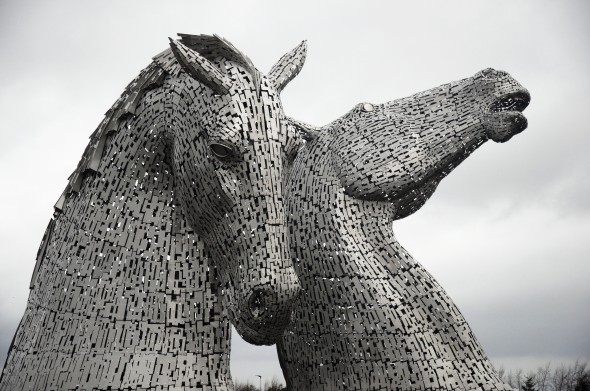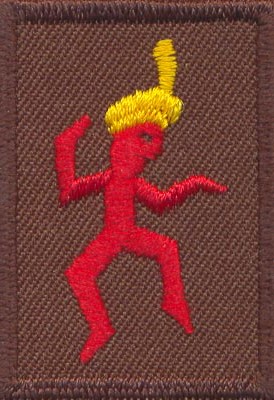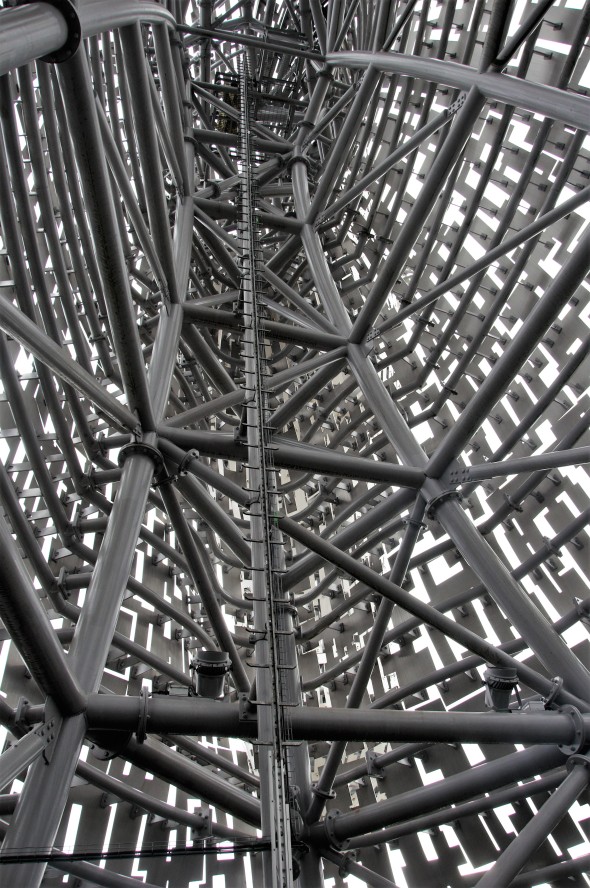The Kelpies

Steve was proof they’re built of sterner stuff up in Scotland. While I was cocooned in a thick winter jumper and padded coat, he went bare armed as he rounded up his tour group outside the visitor centre. I couldn’t help but comment. His eyes crinkled at the edges as he told me that the building had underfloor heating and his body was as efficient as a storage heater. He assured me he’d be warm throughout the tour. I was convinced, however, that I’d see a goose bump or hint of a shiver at some point. After all, you don’t come to Falkirk in February for T-shirt weather.

And it most certainly wasn’t T-shirt weather. Dark concertina folds of cloud crowded the sky and a brisk wind ruffled my hair. I wasn’t too upset. If anything they added drama to an already impressive sight. The two horse heads that formed The Kelpies stood over 30 metres tall. Coming from Glasgow, the first glimpse from the car was as in your face as it got: a massive horse’s mouth emerging from a clump of trees by the side of the motorway. I’d known little about The Kelpies before I’d visited and was taken aback as to how large they were. Excited, I pulled into the Helix car park and was delighted to find it was free. No National Trust price hikes here; this is a community run project and consideration is given to such matters. On a bleak February Saturday, it felt like my willingness to risk the weather had been rewarded and that put a smile on my face.

I had a few minutes to kill before the tour began so I kicked around the site with coffee in hand. What was immediately apparent was that this was as much a community resource as a tourist attraction. Dogs happily chased balls and the kids had brought their scooters. For those wishing to wander along the adjacent Forth & Clyde canal or around The Kelpies, no charge was made. I decided to invest in the £7 required for the tour, keen to find out more about this unique sculpture.

There was plenty to learn. Steve was an enthusiastic guide and worked the small crowd well. “In the three or so years since we’ve been open,” he said, “ten people have fallen into the water. Nine of them were adults!” He grinned and the kids in the group took the bait, ribbing their parents. The shallow moat around the base of The Kelpies wasn’t likely to drown anyone, but given the number of people walking backwards with their eyes glued to their camera screens, it was easy to see how the tally had been achieved.

I’d last visited Falkirk back in the mid 1990s. It hadn’t left a lasting impression. Steve acknowledged that I wasn’t alone in holding such a view. “I’ve lived here for twelve years, Before, when I was asked where I came from I’d say Falkirk.” He muttered into his beard and the name was lost on the wind. “Now, because of The Kelpies, I’m proud to say I’m from Falkirk.” Falkirk Council shared his passion, it would seem. Securing Lottery funding to the tune of around £23m, they and several other interested parties match-funded. The timing of the project wasn’t great, coinciding with the recession, but despite opposition the planned project went ahead. Visitor numbers are looking healthy – an estimated 2 million people have come here since the construction finished in late 2013 and around 200,000 have taken the tour. What was good to hear was that many of those that came were repeat visitors from the local area. Profits from the attraction were ploughed back into local amenities such as local library funding.

The story behind The Kelpies project was fascinating, blending mythology with industrial heritage. The Scottish Kelpie that I’d worn on my Brownie uniform was a little red pixie-like character. “We’re the little Scottish Kelpies, smart and quick and ready helpers,” went the rhyme we chanted. But this sweet image, it would seem, was a con. Of all the Brownie creatures, the Kelpies were the nastiest – malevolent, shape-changing aquatic creatures that commonly took the form of a horse. They’d entice people in their equine form before dragging them underwater to an untimely death. If the media had got hold of that story in time, someone at Brownie HQ would have been fired for sure.

Artist Andy Scott was responsible for the Kelpies at Falkirk and he’d focused on the power and endurance of the beasts rather than their malevolence. The canal-side location was an appropriate setting; horses would have been a common sight, pulling the barges upon which Scotland’s industry relied. In a clever twist, the idea of using the Kelpie reinforced how much the landscape had been transformed too. When choosing a suitable horse to model, Scott took the local Clydesdale breed as his inspiration, with the two muses being Baron (head up) and Duke (head down). The original sketch had been of the entire animal, the water line sketched in and then cropped to ensure the sculpture’s proportions were accurate.

The resultant sculpture is magnificent. The second largest equine structure in the world, they’re beaten in scale only by the monument to Genghis Khan in Mongolia. That stands 40 metres tall, but then Genghis is on top and he’s the star attraction. I’ve seen it, and it’s impressive, but, well, a bit too shiny. The Kelpies would probably be even more of a distraction for drivers on M9 if they had such a sheen, but the matte finish looks more tasteful. Sorry Mongolia, 1-0 to Scotland.

There’s something about the workmanship of The Kelpies that draws your attention and keeps it transfixed. Inside, out of the wind, it’s easier to concentrate on the structure itself. Each of the horse heads used 464 manufactured plates in its construction. Every one is different. They were transported on 150 lorries from Sheffield and took ninety days to be fitted together, in what must have been like an ultimate marathon game of Tetris. At night, they’re lit by LEDs, an energy efficient method costing the equivalent of a pot of tea every night. Now that’s an achievement in itself, don’t you think?

My one disappointment was that it wasn’t possible to climb the structure, though looking at the access ladder for the maintenance crew, you’d need a good head for heights to do so. No matter; the tour’s a must, even at ground level. For more information and to pre-book a slot to see The Kelpies with a guide, please visit the website here:


Lovely, I’d like to see that!
LikeLiked by 1 person
February 24, 2017 at 6:07 pm
Thanks Andrew, they were very cool!
LikeLike
February 24, 2017 at 6:38 pm
Set out to see the Kelpies last winter from Cumbernauld – we had to turn back because of a snowstorm. I still haven’t seem them (apart from the view from the motorway). Must rectify.
Interesting article.
LikeLike
February 24, 2017 at 8:08 pm
Thanks Helen, yes definitely go!
LikeLike
February 24, 2017 at 8:30 pm
Funny you should write about these – I just discovered them yesterday in planning a trip to Scotland this summer! I’m not sure that I’ll go yet, but if I do they are definitely on the list!
LikeLike
February 26, 2017 at 3:29 am
You should, Rachelle. It was fantastically photogenic. If you do go, make sure you head to Glasgow as well. There are some super street murals. I’ve written a blog about it for http://www.go4travelblog.com – it’s not up yet but it should be soon. And knowing your love of cemeteries, you’ll need to go to the Glasgow Necropolis next to the cathedral. I had a brief wander but it’s definitely one to explore properly: http://www.glasgownecropolis.org
LikeLike
February 26, 2017 at 9:08 am
Pingback: A year of travels: looking back on 2017 | Julia's Travels